


Top 10 Tools Transforming the Future of Social Commerce
Social commerce has become one of the biggest drivers of online sales, blending the worlds of social media and eCommerce into one seamless experience. From shoppable feeds and live shopping events to influencer-led affiliate programs, today’s tools make it easier than ever for brands and creators to turn engagement into conversions.
Platforms like Creator Hero and Influencer Hero take it even further — empowering creators to build their own storefronts and helping brands manage influencer collaborations, track affiliate performance, and optimize user-generated content for maximum ROI. Whether you’re a new creator looking to monetize your audience or a brand ready to scale your online presence, the right social commerce platform can help you drive sales directly through social media.
In this list, we’ll explore the top 10 best social commerce tools of 2025 to help you find the perfect fit for your business and make every post count.
Top 10 Best Social Commerce Tools
- Instagram Shop
- TikTok Shop
- Facebook Shops
- Influencer Hero
- Creator Hero
- CommentSold
- Bazaarvoice
- Creator.co
- Tagshop
- LTK
What Is Social Commerce?
Social commerce is the fusion of social media and online shopping — where discovery, engagement, and purchasing all happen on the same platform. Instead of redirecting followers to an external website, brands and creators can now sell products directly through social platforms like Instagram, TikTok, or Facebook. This seamless buying experience shortens the customer journey and turns likes and comments into real conversions.
In simple terms, social commerce lets people shop without ever leaving their favorite social apps. Whether it’s buying through a tagged product in an Instagram Reel or a TikTok Shop link in a creator’s video, the process feels natural and personal. It’s what makes social commerce one of the fastest-growing trends in digital marketing today — and a must-have strategy for both brands and creators.
How Social Commerce Works for Brands
For brands, social commerce is all about creating shoppable moments within social content. Businesses can tag products in posts, set up storefronts, and collaborate with creators to showcase products through authentic content. This builds trust and drives impulse purchases. Many brands also integrate influencer or affiliate programs using tools like Creator Hero or Influencer Hero, making it easier to track performance, manage collaborations, and boost ROI.
How Social Commerce Works for Creators
For creators, social commerce opens new revenue streams. You can earn commissions, run affiliate links, or sell your own digital products — all within your social profiles. Platforms like TikTok Shop and Instagram Shop let creators monetize their influence directly, while tools like Creator Hero make it easy to connect with brands, set up storefronts, and showcase favorite products in one place.
Why Social Commerce Matters
Social commerce is where connection meets conversion. According to recent data, over 50% of Gen Z shoppers have made a purchase based on a creator recommendation. It’s not just about selling — it’s about building communities around brands. By combining storytelling with convenience, social commerce turns followers into loyal customers and creators into key partners in the buying journey.
Top 10 Social Commerce Tools
1. Instagram Shop
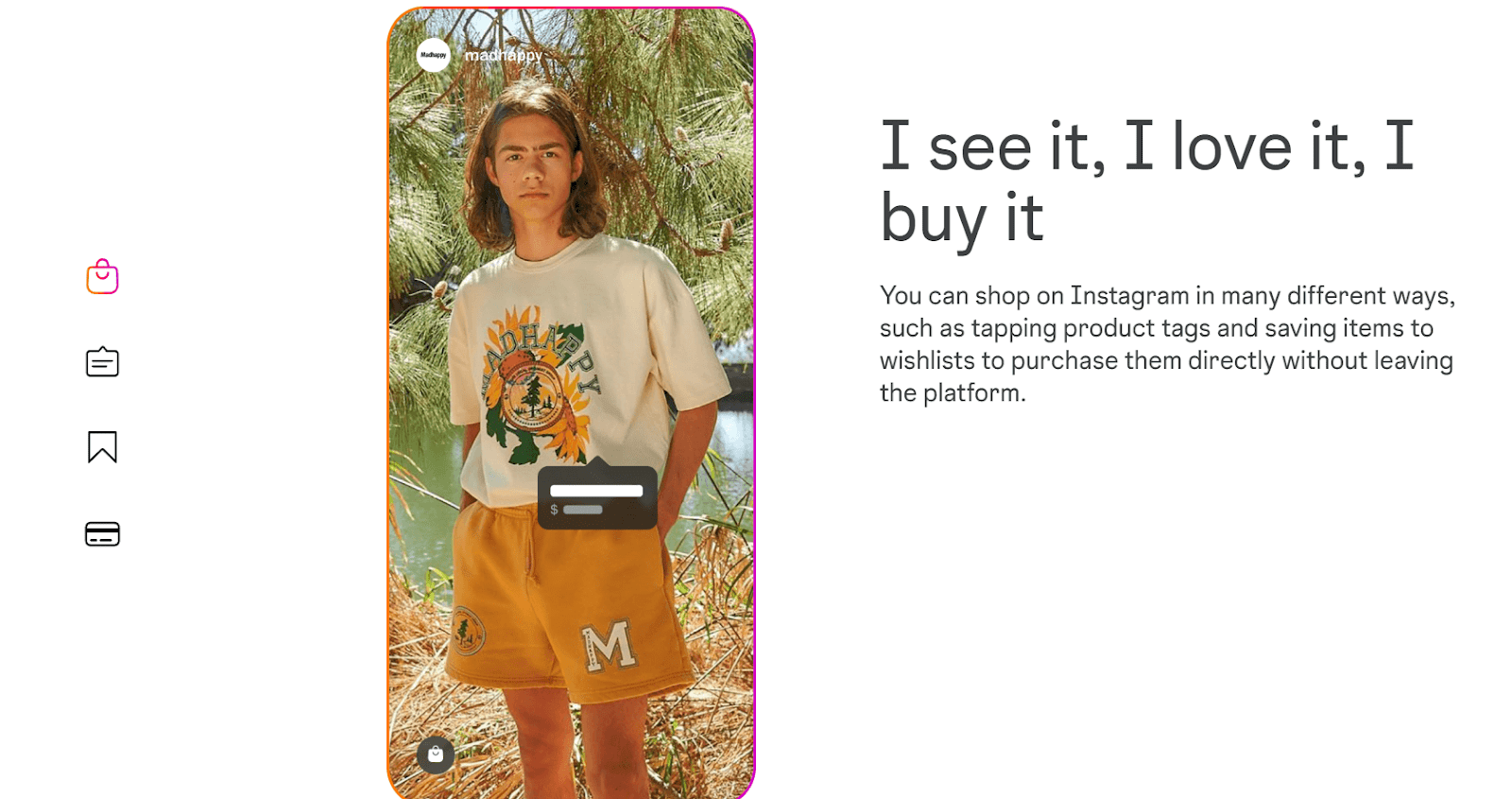
Pricing: Free to set up; selling fees apply (5% per shipment or $0.40 fixed for shipments under $8)
Best for: Brands and creators wanting to sell directly within Instagram
Why It Stands Out
- Native Checkout Experience: Instagram Shop lets users complete purchases without ever leaving the app, making the path from discovery to purchase ultra-smooth and reducing abandonment. This in-app flow is a major advantage over redirect models.
- Product Tagging in Posts & Reels: Products can be tagged within visual content like photos, Reels, and Stories, turning any piece of content into a shoppable moment. This boosts engagement because content and commerce feel integrated.
- Visual-First Format: Instagram’s emphasis on images and video allows brands and creators to present products in aspirational, lifestyle contexts, increasing emotional appeal. Good visuals help products resonate more with followers.
- Cross-Platform Integration: Instagram Shop is part of the Meta ecosystem, so stores, catalogs, and ads sync across Facebook, Instagram, and Messenger. This reduces duplication and makes omnichannel selling easier.
- Insights & Data: The shop and post analytics feed back into advertiser tools, helping you see where users clicked, what converted, and how content performs — enabling better optimization.
Pros
- Seamless in-app checkout
- High visual appeal and discovery
- Strong brand visibility
- Easy integration with Meta ads
- Low barrier to entry
Cons
- Selling fees (5% or fixed fee)
- Checkout not available everywhere
- Algorithm changes impact reach
2. TikTok Shop

Pricing: Free to join, but referral / commission fees apply (~6% per order for most products)
Best for: Brands and creators leaning into short-form video + impulse purchases
Why It Stands Out
- Embedded Shopping in Videos: Products featured in videos are actionable, meaning users can click and purchase directly from the same content without leaving TikTok. This tight coupling of content and commerce makes conversions much more fluid.
- Live Shopping & Creator Events: TikTok supports live shopping sessions, giving creators a chance to demo products in real time, answer questions, and drive urgency. Live formats typically convert at higher rates.
- Creator Integration / Marketplace: Brands can partner via TikTok’s creator/affiliate programs to layer in influencer-driven selling. This helps amplify reach and multiply sales through creators.
- Algorithmic Discovery: TikTok’s algorithmic “For You” page can surface content far beyond your immediate followers, giving brands viral reach potential. This can scale performance rapidly.
- Detailed Metrics & Fees: TikTok provides data on referral fees, transaction fees, and order-level fees (including a $0.05 withdrawal fee) — giving sellers clarity on margin impacts.
Pros
- High potential for viral reach
- Seamless content-to-commerce path
- Live commerce support
- Strong creator / affiliate options
- Transparent fees & metrics
Cons
- Fee structure reduces margins
- Limited to product categories TikTok supports
- Requires consistent video content
- Algorithm fluctuations affect discoverability
- Payment / withdrawal fees
3. Facebook Shops
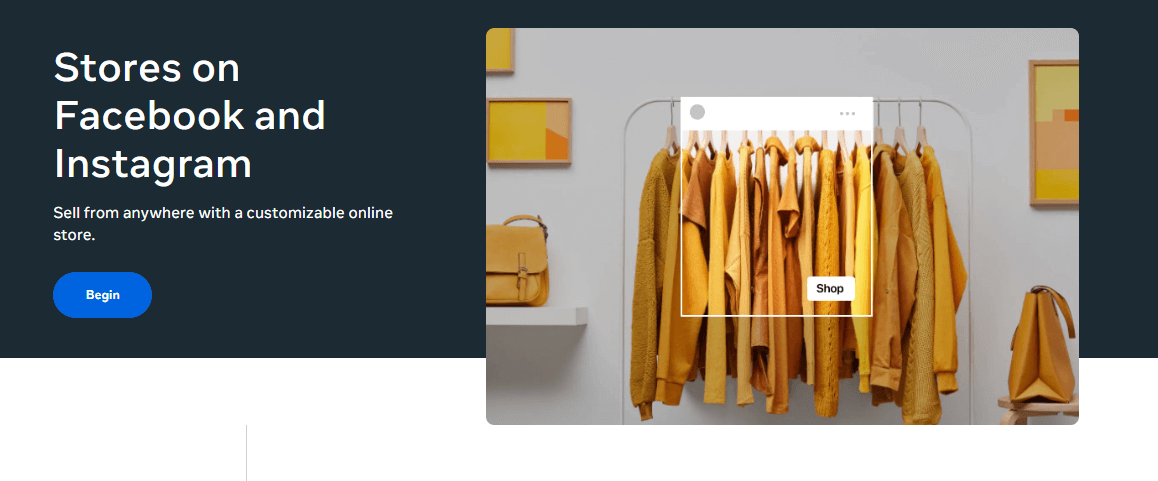
Pricing: Free to set up; transaction / payment processing fees apply (varies by region)
Best for: Brands wanting unified storefronts across Facebook and Instagram
Why It Stands Out
- One Store Across Platforms: Facebook Shops unify your catalog across Facebook, Instagram, and Messenger, letting customers browse and buy everywhere from one backend. This helps you manage inventory, listings, and orders in one place.
- Conversational Commerce: Customers can ask questions, get support, or complete purchases through Messenger or WhatsApp. This direct engagement builds trust and reduces friction.
- Customizable Collections: You can curate collections, feature specific products, and tailor the storefront layout to your brand, improving user experience and guiding discovery.
- Social / Community Selling: Brands can leverage Facebook Groups or Pages to push deals and products to communities already engaging with your brand. This accelerates trust-based sales.
- Ad & Retargeting Integration: Since Facebook Shops live inside the Meta ad ecosystem, you can retarget shoppers, lookalike audiences, and run campaigns seamlessly tied to your product catalog.
Pros
- Unified commerce across Meta’s platforms
- Strong conversational features
- Customizable layout and collections
- Community selling leverage
- Easy ad & catalog integration
Cons
- Needs regular content maintenance
- Visual shopping experience less immersive
- Platform rules may limit layout freedom
- Regional fee variations
- Competition for visibility
4. Influencer Hero
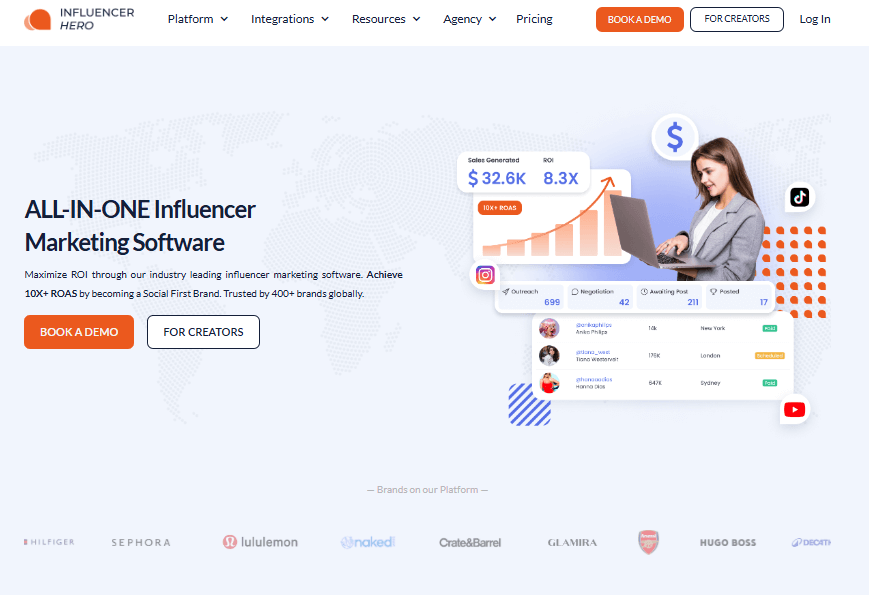
Pricing: Starts at $649/month (Standard), $1,049 (Pro), $2,490 (Business)
Best for: Brands running influencer campaigns and affiliate-driven social commerce
Why It Stands Out
- Full Influencer Suite in One Platform: Influencer Hero covers discovery, outreach, CRM, content tracking, affiliate links, and reporting in a single tool, cutting the need for juggling multiple systems. This all-in-one approach streamlines operations.
- Tiered Plans & Scalability: With multiple subscription levels, brands can scale as needs grow without shifting platforms. Each tier unlocks more outreach and campaign capacity.
- Post & Content Monitoring: The platform automatically tracks influencer posts, UGC, and deliverables, helping you maintain accountability and ensure content compliance.
- Affiliate & Commission Tracking: You can set up affiliate codes or links and see exactly how much each influencer earned, tying content performance directly to sales.
- Transparent Reporting: Dashboards show performance metrics like reach, engagement, conversions, and ROI — helping you optimize campaigns.
Pros
- End-to-end influencer campaign management
- Detailed analytics & ROI tracking
- Strong automation to reduce manual work
- Scalable tiered pricing
- Good content and UGC monitoring
Cons
- Steep learning curve for advanced features
- Price may be high for very small brands
5. Creator Hero
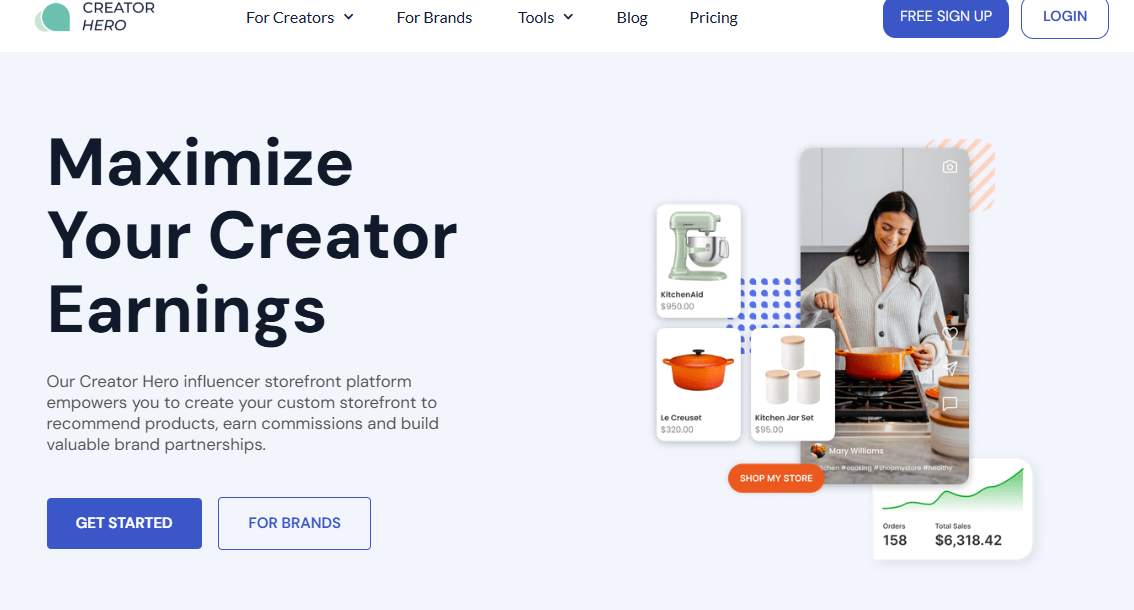
Pricing: Free plan; Pro $19/month; Premium $65/month
Best for: Creators and brands building storefronts and affiliate monetization
Why It Stands Out
- Creator-Focused Storefronts: Creator Hero gives creators their own branded storefront pages to display affiliate / favorite products, making monetization simple and centralized. This helps creators present products more professionally.
- Built-In Analytics: You can view clicks, conversions, earnings, and performance of your storefront or product links through its dashboard. This insight helps creators optimize what works.
- Brand Directory & Partnerships: The platform includes a brand directory where creators and brands connect. This feature helps creators discover partnership opportunities.
- Affordable & Tiered Plans: With low-cost Pro and Premium tiers, many creators can get started with monetization without high overhead. The Premium plan gives more visibility and priority access.
- User-Friendly Setup: The platform is designed for creators with minimal tech knowledge — setup is intuitive and doesn’t require coding or complex integration.
Pros
- Extremely affordable plans for creators
- Easy, no-code storefront setup
- Analytics built in
- Good for affiliate / product-based monetization
- Connects creators with brands
Cons
- Free / lower tiers have limited visibility or customization
- More suited for affiliate revenue than full eCommerce
6. CommentSold
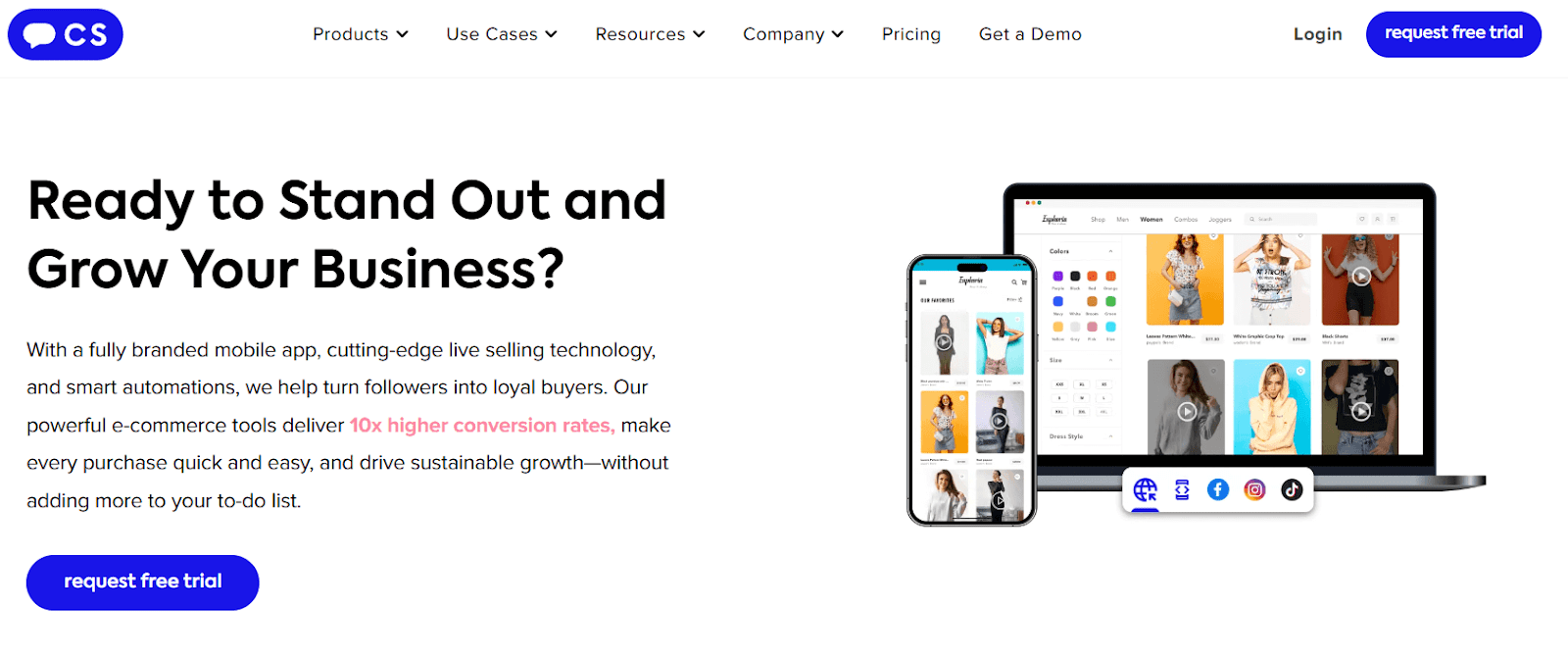
Pricing: Starter $149/month + 5% of sales; Small Business $499/month + 4%; Large $999/month + 3%
Best for: Brands doing live shopping and real-time commerce
Why It Stands Out
- Live-Commerce Focus: CommentSold specializes in converting live streams into sales — customers comment when they want to buy and the system automates invoicing. This real-time interactivity drives higher conversions.
- Cross-Platform Streaming: You can host live shows on platforms like Facebook, Instagram, TikTok, or embed them on your own site — making the experience seamless and multichannel.
- Automation & Invoicing: The tool handles billing, inventory, and order follow-ups automatically after a buyer comments “sold” — saving brands time and reducing friction.
- Loyalty & Retention Tools: Features like rewards programs, recurring orders, and buyer watchlists help convert one-time viewers into repeat customers.
- Analytics for Live Events: You can review viewer counts, conversion rates, average order value, and product-level performance to improve future live sessions.
Pros
- Powerful live selling capabilities
- Automated checkout from comments
- Multi-platform live support
- Customer loyalty tools
- Insights on live performance
Cons
- Requires constant live content
- Steep learning curve initially
- Platform cost + percentage fees reduce margins
- Live show infrastructure must be reliable
- Viewer fatigue possible
7. Bazaarvoice
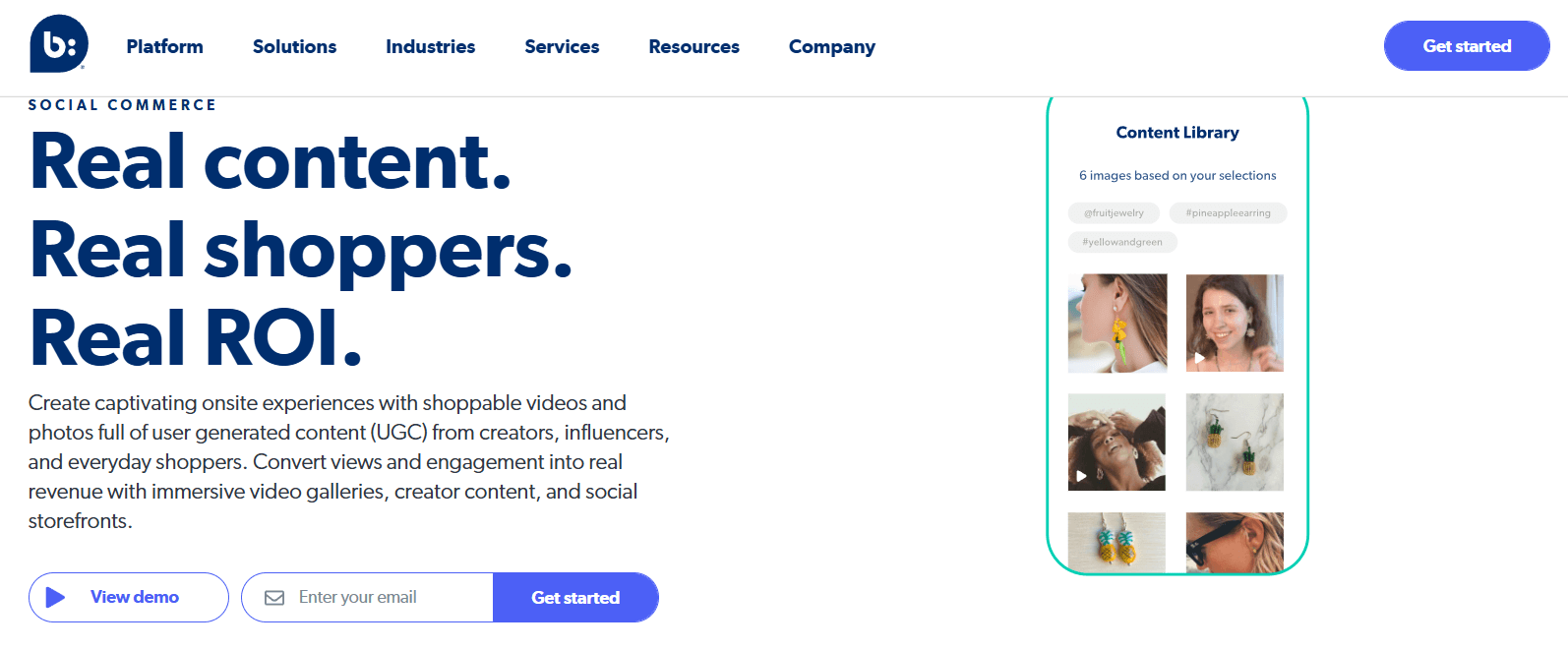
Pricing: Custom / enterprise (contact for quote)
Best for: Brands leveraging user-generated content, reviews, and social proof
Why It Stands Out
- Shoppable UGC Galleries: Bazaarvoice collates customer photos, reviews, and social content into shoppable galleries on product pages. This converts social proof directly into commerce.
- Verified Review System: The platform emphasizes authenticity with verified reviews, reducing buyer hesitation and building trust.
- Influencer & Creator UGC Integration: Brands can combine influencer-generated content and loyal customers’ content into galleries, amplifying reach and variety.
- Cross-Channel Syndication: Content and reviews can be shared across product pages, social channels, and ad assets, maximizing utility.
- Deep Analytics & Insights: The system measures impressions, engagement, conversions, and content performance to guide content and product strategy.
Pros
- Boosts trust via verified UGC
- Powerful content syndication
- Integrates influencer and customer content
- Detailed analytics
- Suitable for large-scale brands
Cons
- Expensive for small brands
- Requires steady volume of content
- Long onboarding and integration
- Complex for non-enterprise teams
- May require dedicated team support
8. Creator.co
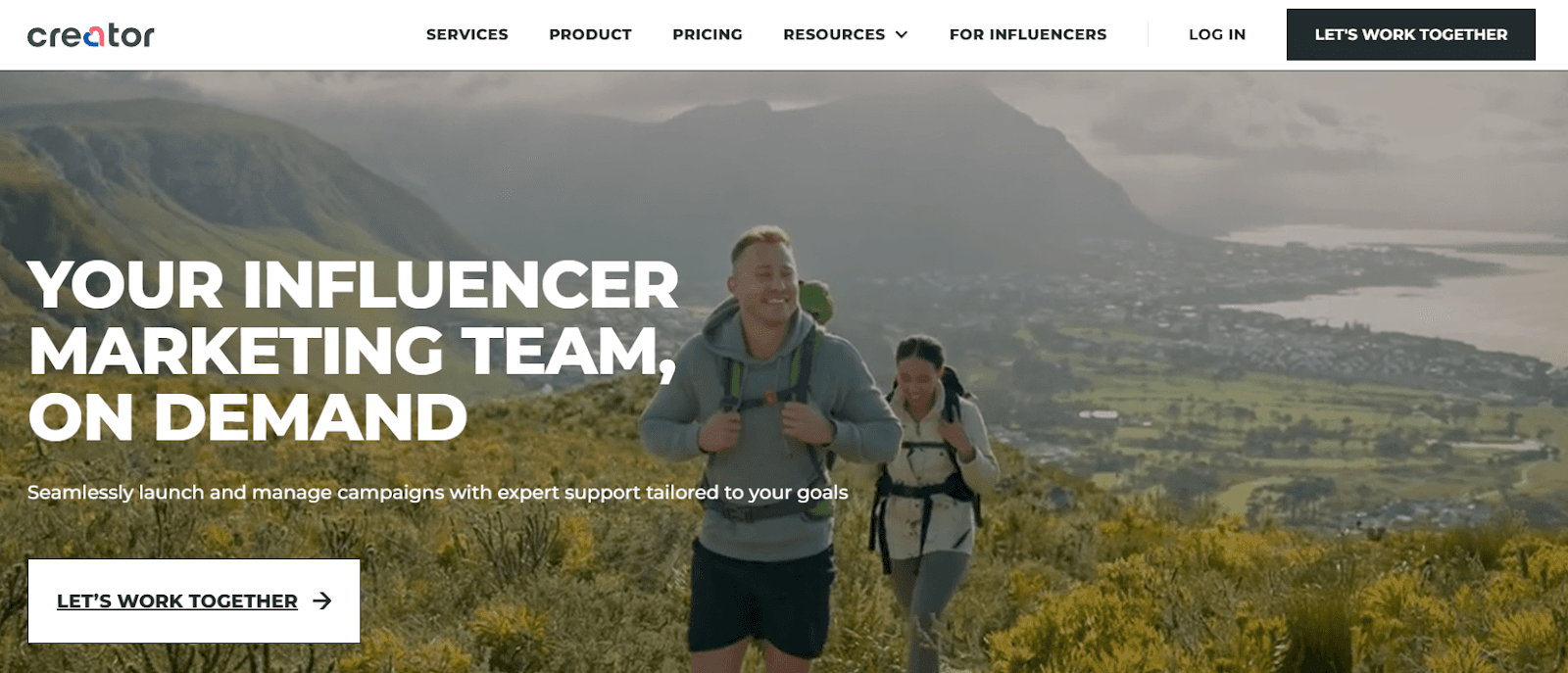
Pricing: Pro plan ~ $460/month (Plus custom for large scale)
Best for: Brands running influencer and affiliate-based campaigns
Why It Stands Out
- Creator Discovery & Matching: Creator.co connects brands with vetted creators aligned to their niche, speeding up the search and selection process.
- Campaign Management Platform: Brand teams can deploy, monitor, and optimize influencer campaigns all in one dashboard — from outreach to content approval.
- Affiliate / Incentive Tools: The platform supports affiliate links, performance-based bonuses, and commission tracking — aligning creator incentives with results.
- Community & Support: Creator.co fosters a community where creators and brands can connect, share best practices, and collaborate. This network effect strengthens campaigns.
- Data & Insights: The platform tracks performance metrics like reach, engagement, content ROI, and sends alerts on underperforming campaigns.
Pros
- Streamlined influencer campaign orchestration
- Affiliate / performance-based incentives
- Built-in creator-brand connections
- Data-driven optimization tools
- Strong support and community features
Cons
- High monthly cost even for mid-tier campaigns
- Complexity in managing many creators
- Onboarding takes effort
- Limited flexibility for niche micro-creators
- Brand / creator match may not always align
9. Tagshop

Pricing: Free starter plan; paid plans begin around $49/month
Best for: eCommerce brands turning social / influencer content into shoppable galleries
Why It Stands Out
- Shoppable Post Galleries: Tagshop turns Instagram posts, influencer images, and customer photos into clickable galleries on your site, making it easy to shop from visual content.
- Seamless Platform Integration: It works with major eCommerce platforms (Shopify, WooCommerce, Magento) so syncing products and galleries is smooth.
- Product Tagging in Posts: You can tag specific products within chosen images, linking directly to product pages — shortening the path to purchase.
- Boosts Social Proof: Featuring real user- or influencer-generated visuals helps build credibility, authenticity, and confidence in purchases.
- Analytics & Conversion Tracking: Tagshop tells you which images or tags drove clicks, engagement, and sales — helping refine future content.
Pros
- Easy to set up and use
- Great way to leverage UGC visuals
- Low cost entry
- Integration with popular eCommerce platforms
- Encourages authentic social commerce
Cons
- Limited features in free tier
- Customization constraints in lower plans
- Relies heavily on image-rich brands
- Conversion rates depend on content quality
- Less support / features for global scaling
10. LTK (LIKEtoKNOW.it)
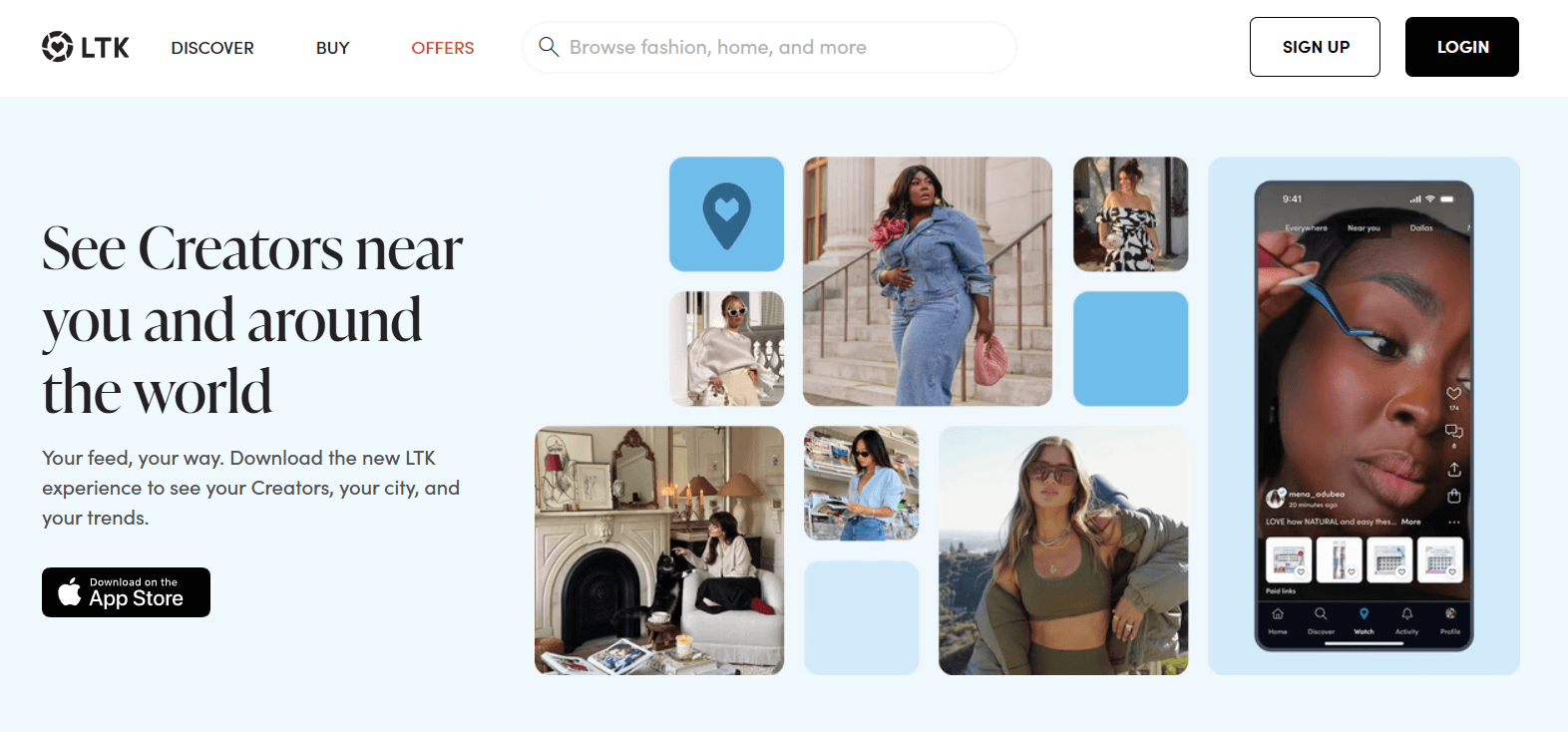
Pricing: Free for creators; brands pay commission fees and affiliate program costs
Best for: Influencers in lifestyle, fashion, beauty monetizing recommendations
Why It Stands Out
- Creator Monetization Platform: LTK empowers creators to earn via affiliate links, allowing followers to shop exactly what they feature — turning inspiration into direct sales.
- Seamless Multi-Channel Distribution: Content can be shoppable across Instagram, blogs, YouTube, and more — maximizing creator reach and earning potential.
- Credibility and Trust: Because LTK is established, followers often trust product recommendations placed through it more readily, boosting conversion potential.
- Strong Retail Partnerships: LTK works with many major retailers, giving creators a broad catalog to promote.
- Intuitive Analytics: Creators get data on clicks, conversion rates, and earnings, helping refine promotional strategy.
Pros
- Excellent monetization model for creators
- Trusted platform & network
- Broad affiliate access
- Multipoint distribution
- Solid analytics support
Cons
- Limited store customization
- High competition among creators
- Commission fees impact margins
- Approval process for new creators
- Less flexibility for non-lifestyle niches
Final Thoughts: Turn Every Post Into a Sales Opportunity
Social commerce is no longer just a trend — it’s the new way people shop. With platforms like Instagram Shop and TikTok Shop making content instantly shoppable, and tools like Influencer Hero and Creator Hero bridging the gap between creators and conversions, you have everything you need to build a profitable presence online.
Whether you’re a brand aiming to boost ROI or a creator looking to monetize your influence, the right tool can help you turn engagement into revenue. Explore these platforms, test what fits your strategy, and start transforming your social content into real sales today.



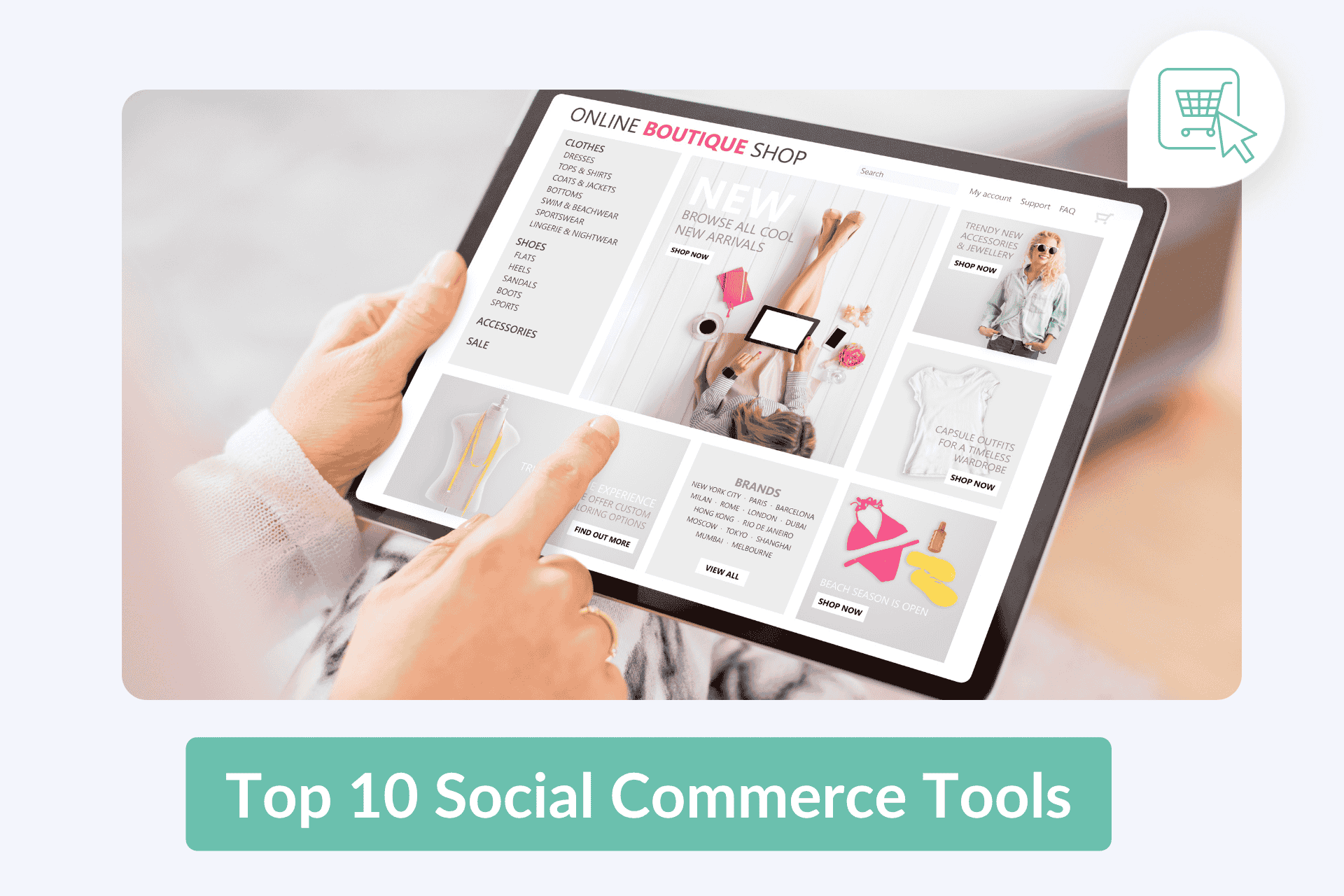

.svg)

%201.png)

%20(1).jpg)










_logo.svg.png)








